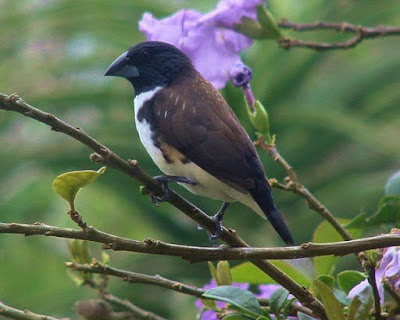Attendees: Stan & Val Culley, Eric & Christine Kok, Cathy Lee, Andy Ruffle, Bob & Hazel van Rooyen, Willie & Wilna van Zyl, Ron Whitham, Margie & Pete Williamson. (13 attendees)
The weather finally allowed us to visit Lake Eland Game Reserve on Saturday, with a good turnout.
It was very nice to welcome Bob & Hazel van Rooyen our latest members.
The day started off well with a sighting of a rather bedraggled Yellow-billed Kite resting on a dead branch, as we took our normal route down to the picnic site. Funny how we really miss these birds during the winter.
After breakfast we decided to revisit the large lake, something we haven't done for a long time.
The road there was a little rough, so our decision to pile into high clearance vehicles was a good one.
No sign of the Finfoot on the river I'm afraid, this probably due to the fast flowing water which was pouring over the low bridge.
At the Lake, Greater Honeyguide and Southern Tchagra could be heard calling up on the hills, but neither showed themselves. It was a different matter, however, with a pair of Black-crowned Tchagra who were foraging amongst the mown grass like pipits. They were so accomodating, allowing Stan to get some photos through his scope.
Following our hearty lunch, some of us carried on to the suspension bridge to see the African Fish-eagle which is sitting on her nest. The eggs are very close to hatching, but she was still sitting tight.
If this wasn't a wonderful enough sight in itself, we were treated to, albeit distant, views of a Peregrine Falcon perched on the cliffs. Our original supposition that it must be a Lanner, thwarted when Ron enlarged a photo he had taken. It was unmistakebly a Peregrine.
The day ended with a spectacular flypast by a glowing Rock Kestrel.
Species recorded: Cape Turtle-dove, Common Starling, Yellow-billed Kite, Hadeda Ibis, Village Weaver, African Stonechat, Common Fiscal, Cape Longclaw, Pied Crow, Dark-capped Bulbul, Cape Weaver, Yellow-throated Longclaw, Cape Robin-chat, Levaillant's Cisticola, White-browed Scrub-robin, Southern Boubou, Red-throated Wryneck, Brimstone Canary, Black-crowned Tchagra, Amethyst Sunbird, Cape Glossy Starling, Fork-tailed Drongo, Black-headed Oriole, Red-eyed Dove, Cape Canary, Long-crested Eagle, Black-collared Barbet, Golden-breasted Bunting, Streaky-headed Seedeater, Olive Sunbird, Cardinal Woodpecker, Cape White-eye, Neddicky, Spectacled Weaver, Cape Grassbird, African Darter, Croaking Cisticola, Rufous-naped Lark, Cape Wagtail, African Black Duck, Egyptian Goose, Bar-throated Apalis, Knysna Turaco, Crowned Hornbill, Ashy Flycatcher, Scaly-throated Honeyguide, Jackal Buzzard, Green Wood-hoopoe, Greater Honeyguide, Yellow-billed Duck, Malachite Kingfisher, African Shelduck, Southern Black Flycatcher, Southern Tchagra, Tawny-flanked Prinia, Sombre Greenbul, Red-billed Teal, Speckled Pigeon, White-necked Raven, Cape Vulture, Red-winged Starling, Rock Kestrel, Peregrine Falcon, African Harrier-hawk. (64 species)










